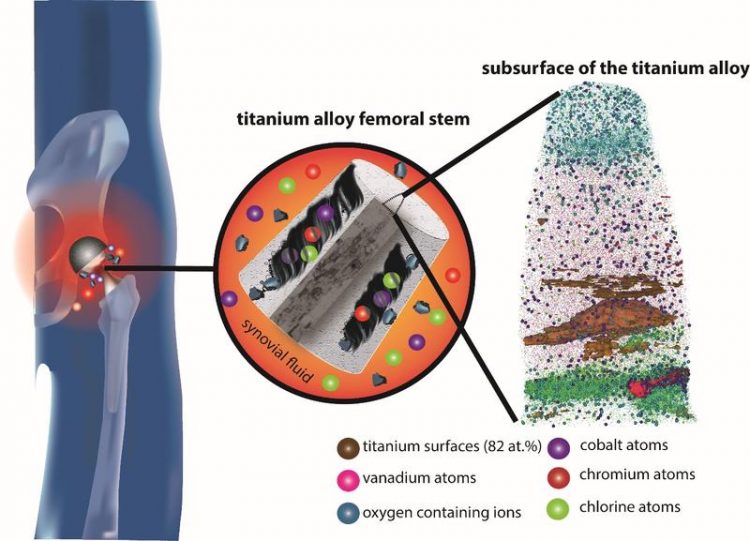Understanding Metal Ion Release from Hip Implants

Atom Probe Tomography helps in understanding the metal ion release of hip implants S. Balachandran, Z. Zachariah, et al: Advanced Science 2020, 1903008
1.8 million hip replacement surgeries were performed in developed countries in 2015. Due to lifestyle choices and a higher life expectancy, it is estimated that the number of total hip arthroplasties will increase to 2.8 million in 2050. At the end of the last millennium, artificial hip implants lasted only about 10 years.
Since then physicians teamed up with material scientists to build longer lasting devices, with the goal to avoid any revision operations after implantation. One of the problems is the release of tiny small metal particles and ions into the surrounding tissue, a process accelerated by micromotion and corrosion between the modular parts of the artificial hip.
To identify the underlying atomic-scale mechanisms, Dr. Michael Herbig, leader of the group “Material Science of Mechanical Contacts” at the Max-Planck-Institut für Eisenforschung (MPIE), and his team analysed cobalt and titanium alloys used in hip implants.
The scientists modelled the loads and environment of the hip joint after surgery experimentally in the laboratory in collaboration with Prof. Alfons Fischer and Prof. Markus Wimmer, from the Rush University Medical Center in Chicago, USA. The results were recently published in the journal Advanced Science.
“Typical hip implants consist of a cobalt alloy femoral head fixed on a titanium alloy femoral stem. Fretting and corrosion at the junction of head and stem lead to so-called ‘tribocorrosion’ meaning that metal particles and ions are released into the body of the patient. The resulting adverse local tissue reactions could make it necessary to eventually revise the implant”, explains Dr. Shanoob Balachandran, first author of the publication together with his colleague Dr. Zita Zacharia, both postdoctoral researchers in the Mechanical Contacts Group.
Using the high-end techniques ‘atom probe tomography’ and ‘transmission electron microscopy’, it was revealed that a subsurface folding mechanism of the titanium alloy takes place, which leads to the formation of ‘shelves’ rising above surface.
“The shelves poke out of the titanium alloy surfaces and scratch the opposing cobalt alloy surface, hence promoting tribocorrosion of the cobalt head. And this in turn leads to the release of metal ions”, explains Herbig.
During the folding process, surface titanium and chromium oxides, in addition to chlorine from the surrounding serum are incorporated into the shelves leading to an intermixing with the matrix phases. The problem is that during the folding process a part of the oxides could be released and accumulate in the surrounding tissues instead of being incorporated into the implant.
“But how can this folding process be inhibited and how do the proteins present in synovial fluid affect the alloys’ dissolution? This would be the next step of our research in order to pave the way of developing tribocorrosion resistant alloys for medical applications.”, states Zacharia.
Dr. Michael Herbig, herbig@mpie.de
S. Balachandran, Z. Zachariah, A. Fischer, D. Mayweg, M. A. Wimmer, D. Raabe, M. Herbig: Atomic scale origin of metal ion release from hip implant taper junctions. In: Advanced Science 2020, 1903008
Media Contact
All latest news from the category: Materials Sciences
Materials management deals with the research, development, manufacturing and processing of raw and industrial materials. Key aspects here are biological and medical issues, which play an increasingly important role in this field.
innovations-report offers in-depth articles related to the development and application of materials and the structure and properties of new materials.
Newest articles

Machine learning algorithm reveals long-theorized glass phase in crystal
Scientists have found evidence of an elusive, glassy phase of matter that emerges when a crystal’s perfect internal pattern is disrupted. X-ray technology and machine learning converge to shed light…

Mapping plant functional diversity from space
HKU ecologists revolutionize ecosystem monitoring with novel field-satellite integration. An international team of researchers, led by Professor Jin WU from the School of Biological Sciences at The University of Hong…

Inverters with constant full load capability
…enable an increase in the performance of electric drives. Overheating components significantly limit the performance of drivetrains in electric vehicles. Inverters in particular are subject to a high thermal load,…





















